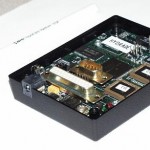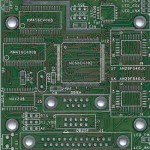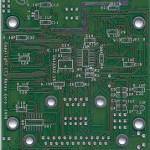Today, lots of devices such as robots, cameras, and many other appliances are connected to the Internet. Most of these devices use very simple communication protocols like RS-232C. To connect these devices, we need a sort of gateway between these simple protocol and the Internet. Of course, we can use a PC as a gateway, but usually PC is too big and expensive to be used for this purpose. So, we need a very small, inexpensive, general purpose web server that can be working as a gateway between these simple protocol and the Internet. The answer is Hydra.
Development
The Hydra was designed and developed by Roy Want, Kurt Partridge, and Frank Vest at Xerox PARC. Linux porting was done by Jong Hee Kang at the University of Washington. Hydra is no longer an active project.
Hardware
– Specification
- CPU : 68EN302 20MHz
- Memory
- FLASH ROM : 1 MB
- RAM : 8 MB (expandable to 16MB)
- Communication ports
- 1 Serial Port
- 1 Parallel Port
- 1 Ethernet Port
– Size : 3 x 4 in.
Software
– Operating System : Linux
- Started with uClinux – linux for PalmPilot.
– Other Applications
- A Small Web Server
- Telnet daemon
- Other device controlling programs
Many devices are connected to the Internet
These days, many devices are connected to the Internet. Some refrigerators are connected to the Internet and the status of the refrigerators such as temperature, whether the door is open or not, current stock can be checked through the web browser. And, there are many telerobots in the Internet these days. A telerobot is a robot which can be controlled remotely through the network. And, there is a laundry machine connected to the Internet and the current status of the machine can be checked remotely. And, Some people wire their home and control all the appliances in their home remotely. There is a house where the doorbell is connected to the Internet and if the doorbell rings, then an email is sent to the owner of the house. Also, a phone and a caller-ID unit are connected to the Internet and the owner can check the recent calls throuth the Internet. There can be many other applications that may need the Internet-connected devices.
How the Hydra can be used?
- Connecting devices to the Internet
The Hydra can be used for connecting devices to the Internet. Here are some examples of this case.- Home Automation
Many home appliances can be connected to the Internet and controlled via web browser. - Web Camera
Cameras can be connected to the Internet through the Hydra, and the Internet users can change the direction of the camera.
- Home Automation
- Internet portal for handheld devices
The Hydra can also be used as an Internet portal for the handheld devices such as PalmPilot, Nino, etc.- Using IrDA
The network connection through the wireless modem is still expensive. So, it’s a good idea to use builtin infrared port of handheld devices for accessing the Internet. The Hydra can be used as a gateway between IrDA and IP by plugging IrDA dongle into the serial port of the Hydra and installing appropriate software on it. IrDA porting is in progress now.
PCs can also be used for this purpose, but PCs are too big and cannot be deployed easily. For example, it’s not easy to put PCs in the corridor or the gymnasium. The Hydra can be easily deployed in such places. - Using RF
In the infrared communication, the two devices must be in the line of sight, and it doesn’t work if the two devices are too far away. RF doesn’t have such limitations. So, RF can be used like an infrared without such limitations.
- Using IrDA
Hydra Board
The Hydra board was designed by Roy Want, Kurt Partridge, and Frank Vest when Kurt was working as a summer intern at Xerox Parc in 1998.
- Hydra panel
- Hydra front board
- Hydra Back



